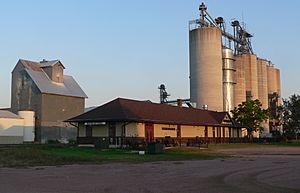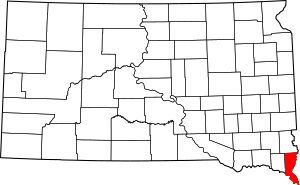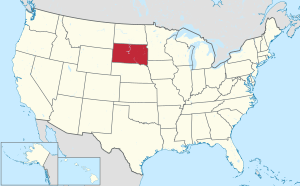Union County, South Dakota facts for kids
Quick facts for kids
Union County
|
|
|---|---|

Chicago and North Western Railway depot in Beresford, South Dakota
|
|

Location within the U.S. state of South Dakota
|
|
 South Dakota's location within the U.S. |
|
| Country | |
| State | |
| Founded | April 10, 1862 |
| Seat | Elk Point |
| Largest community | Dakota Dunes |
| Area | |
| • Total | 467 sq mi (1,210 km2) |
| • Land | 461 sq mi (1,190 km2) |
| • Water | 6.6 sq mi (17 km2) 1.4% |
| Population
(2020)
|
|
| • Total | 16,811 |
| • Estimate
(2023)
|
17,183 |
| • Density | 36.00/sq mi (13.899/km2) |
| Time zone | UTC−6 (Central) |
| • Summer (DST) | UTC−5 (CDT) |
| Congressional district | At-large |
Union County is the southernmost county in the U.S. state of South Dakota. As of the 2020 census, the population was 16,811, making it the 13th most populous county in South Dakota. Its county seat has been Elk Point since April 30, 1865. Originally named Cole County, its name was changed to Union on January 7, 1864, because of Civil War sentiment.
Union County is part of the Sioux City, IA–NE–SD Metropolitan Statistical Area. The Progressive Farmer rated Union County second in the "2006 Best Place to Live Survey" in the U.S., because "its schools are good, its towns neat and its people friendly".
Contents
History
Founded on April 10, 1862, as Cole County, it was renamed Union County on January 7, 1864, when its boundaries were changed to encompass land previously part of neighboring Lincoln County. The county seat was moved from Richland to Elk Point on April 30, 1865.
Geography
Union County lies on the southeast corner of South Dakota. Its east boundary line abuts the west boundary line of the State of Iowa (across the Big Sioux River), and its south/southwest boundary line abuts the north boundary line of the State of Nebraska (across the Missouri River). The Brule Creek flows southeasterly across the central part of the county, emptying into the Big Sioux. The county terrain consists of rolling hills, devoted to agriculture except around built-up areas. The terrain slopes to the south and east; its highest point is near its northwest corner, at 1,509 ft (460 m) ASL. The county has a total area of 467 square miles (1,210 km2), of which 461 square miles (1,190 km2) is land and 6.6 square miles (17 km2) (1.4%) is water. It is the fifth-smallest county in South Dakota by area.
Major highways
Adjacent counties
- Lincoln County to the north
- Sioux County, Iowa to the northeast
- Plymouth County, Iowa to the east
- Woodbury County, Iowa to the southeast
- Dakota County, Nebraska to the south
- Dixon County, Nebraska to the southwest
- Clay County to the west
Protected areas
- Adams Homestead and State Nature Preserve
- Bent River State Game Production Area
- Bolton State Game Production Area
- Cusick State game Production Area
- Cut Off Bend State Game Production Area
- Missouri National Recreational River (partial)
- Petry-Conway State Game Production Area
- Petry/Harmelink State Game Production Area
- Ryan State Game Production Area
- Union Grove State Park
- Warren Wilderness State Game Production Area
Lakes
- Burbank Lake (partial)
- McCook Lake
- Mud Lake
Demographics
| Historical population | |||
|---|---|---|---|
| Census | Pop. | %± | |
| 1870 | 3,507 | — | |
| 1880 | 6,813 | 94.3% | |
| 1890 | 9,130 | 34.0% | |
| 1900 | 11,153 | 22.2% | |
| 1910 | 10,676 | −4.3% | |
| 1920 | 11,099 | 4.0% | |
| 1930 | 11,480 | 3.4% | |
| 1940 | 11,675 | 1.7% | |
| 1950 | 10,792 | −7.6% | |
| 1960 | 10,197 | −5.5% | |
| 1970 | 9,643 | −5.4% | |
| 1980 | 10,938 | 13.4% | |
| 1990 | 10,189 | −6.8% | |
| 2000 | 12,584 | 23.5% | |
| 2010 | 14,399 | 14.4% | |
| 2020 | 16,811 | 16.8% | |
| 2023 (est.) | 17,183 | 19.3% | |
| U.S. Decennial Census 1790-1960 1900-1990 1990-2000 2010-2020 |
|||
2020 census
As of the 2020 census, there were 16,811 people, 6,822 households, and 4,613 families in the county. The population density was 36.5 inhabitants per square mile (14.1/km2). There were 7,215 housing units.
2010 census
As of the 2010 census, there were 14,399 people, 5,756 households, and 4,043 families in the county. The population density was 31.3 inhabitants per square mile (12.1/km2). There were 6,280 housing units at an average density of 13.6 per square mile (5.3/km2). The racial makeup of the county was 95.5% white, 0.9% Asian, 0.7% black or African American, 0.6% American Indian, 0.1% Pacific islander, 0.7% from other races, and 1.6% from two or more races. Those of Hispanic or Latino origin made up 2.1% of the population. In terms of ancestry, 42.0% were German, 18.2% were Norwegian, 17.7% were Irish, 7.9% were English, 6.8% were Swedish, and 3.7% were American.
Of the 5,756 households, 32.8% had children under the age of 18 living with them, 58.9% were married couples living together, 7.5% had a female householder with no husband present, 29.8% were non-families, and 25.1% of all households were made up of individuals. The average household size was 2.49 and the average family size was 2.98. The median age was 40.2 years.
The median income for a household in the county was $59,889 and the median income for a family was $71,308. Males had a median income of $42,702 versus $31,993 for females. The per capita income for the county was $33,783. About 3.9% of families and 4.9% of the population were below the poverty line, including 4.3% of those under age 18 and 10.5% of those age 65 or over.
Communities
Cities
- Alcester
- Beresford (partial)
- Elk Point (county seat)
- Jefferson
- North Sioux City
Census-designated places
Unincorporated communities
- Alsen
- Garryowen
- Junction City
- McCook Lake
- Midway
- Nora
- Spink
- Wynstone
Ghost towns
- Emmet
- Gothland (Alcester Twp)
- Hill Side (Emmet Twp)
- Texas (Elk Point Twp)
- Morganfield
Townships
- Alcester
- Big Sioux
- Big Springs
- Brule
- Civil Bend
- Elk Point
- Emmet
- Jefferson
- Prairie
- Richland
- Sioux Valley
- Spink
- Virginia
Unorganized territory
- Richland
See also
 In Spanish: Condado de Union (Dakota del Sur) para niños
In Spanish: Condado de Union (Dakota del Sur) para niños

